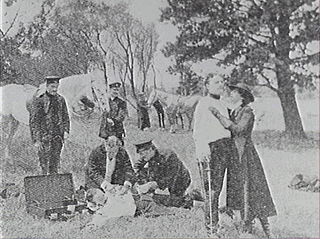Related Research Articles
John F. Gavin, born as John Francis Henry Gavin was an Australian film director, who was one of the early filmmakers of the 1910s. He is best known for making films about bushrangers such as Captain Thunderbolt, Captain Moonlite, Ben Hall and Frank Gardiner. He was known by the nickname "Jack" and worked in collaboration with his wife Agnes, who wrote many of his films, most of which have not survived.

Lottie Lyell, born Charlotte Edith Cox, was an Australian actress, screenwriter, editor and filmmaker. She is regarded as Australia's first film star, and also contributed to the local industry during the silent era through her collaborations with director and writer Raymond Longford.

Raymond Longford was a prolific Australian film director, writer, producer and actor during the silent era. Longford was a major director of the silent film era of the Australian cinema. He formed a production team with Lottie Lyell. His contributions to Australian cinema with his ongoing collaborations with Lyell, including The Sentimental Bloke (1919) and The Blue Mountains Mystery (1921), prompted the Australian Film Institute's AFI Raymond Longford Award, inducted in 1968, named in his honour.

Moonlite is a 1910 bushranger film about Captain Moonlite, played by John Gavin, who also directed. It was also known as Captain Moonlite and is considered a lost film.
Agnes Gavin (1872–1947), was an Australian actor and screenwriter in the silent film era. She worked in collaboration with her husband John Gavin throughout her career. She wrote the majority of his films and was arguably the first specialist screenwriter in the history of the Australian film industry. In newspapers she was advertised as the "well known picture dramatizer" and was praised for creating "cleverly constructed stories". Many of her films are considered lost.
Assigned to his Wife is a 1911 Australian silent film from director John Gavin. It is a convict-era "military romantic melodrama".

The Romantic Story of Margaret Catchpole is a 1911 Australian silent film directed by Raymond Longford and starring Lottie Lyell. It is based on the true story of Margaret Catchpole, an adventurer and convict.
Sweet Nell of Old Drury is a 1911 Australian silent film directed by Raymond Longford starring Nellie Stewart about the relationship between Nell Gwynne and King Charles II. It is based on the 1900 play of the same name by Paul Kester which Stewart had performed numerous times on stage.

The Midnight Wedding is a 1912 Australian silent film directed by Raymond Longford based on a popular Ruritanian stage play in which Longford had appeared. It is considered a lost film.
The Pioneers is a 1926 Australian silent film directed by Raymond Longford. The script had been written by Lottie Lyell but she had died by the time filming started. It was considered a lost film but some surviving footage from it has recently emerged.
Alfred Rolfe, real name Alfred Roker, was an Australian film director and actor, best known for being the son-in-law of the celebrated actor-manager Alfred Dampier, with whom he appeared frequently on stage, and for his prolific output as a director during Australia's silent era, including Captain Midnight, the Bush King (1911), Captain Starlight, or Gentleman of the Road (1911) and The Hero of the Dardanelles (1915). Only one of his films as director survives today.
It Is Never Too Late to Mend is an Australian feature-length silent film written and directed by W. J. Lincoln. It was based on a stage adaptation of the popular 1865 novel It Is Never Too Late to Mend: A Matter-of-Fact Romance by Charles Reade about the corrupt penal system in Australia. It was called "certainly one of the best pictures ever taken in Australia."

Captain Midnight, the Bush King was a 1911 Australian silent drama film about the fictitious bushranger Captain Midnight which was the directorial debut of actor Alfred Rolfe. The film is based on the play of same name by W. J. Lincoln and Alfred Dampier. Captain Midnight, the Bush King is now considered lost.
Captain Starlight, or Gentleman of the Road is a 1911 Australian silent film about the bushranger Captain Starlight. It was based on Alfred Dampier's stage adaptation of the novel Robbery Under Arms.
The Life of Rufus Dawes is a 1911 Australian silent film based on Alfred Dampier's stage adaptation of the novel For the Term of His Natural Life produced by Charles Cozens Spencer.
The Lady Outlaw is a 1911 Australian silent film set in Van Diemen's Land during convict days.
The Cup Winner is a 1911 Australian silent film directed by Alfred Rolfe. It is set against a backdrop of horseracing and the finale involves real footage from the 1911 Melbourne Cup.
Dan Morgan is a 1911 Australian film from Charles Cozens Spencer about the bushranger Dan Morgan.
The Australian Photo-Play Company was a short-lived but highly productive Australian film production company which operated from 1911 to 1912.
Edward Irham Cole was an Australian film director and theatrical entrepreneur who specialised in Wild West shows.
References
- ↑ "MUSIC AND DRAMA." The Sydney Morning Herald 23 Feb 1929: 12 accessed 14 Dec 2011
- ↑ "Roland McCarty Presents Augustus Neville". The Catholic Press . NSW: National Library of Australia. 19 February 1931. p. 26. Retrieved 20 February 2014.
- ↑ "It All Began With a Feature Movie On The Kelly Gang". The News . Adelaide: National Library of Australia. 16 November 1946. p. 2. Retrieved 20 February 2014.
- ↑ "NEW FILMS". The Sydney Morning Herald . National Library of Australia. 7 June 1926. p. 5. Retrieved 20 February 2014.